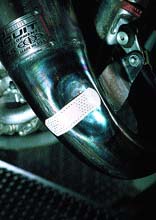DYNO DAZE: THE TRUTH ABOUT SPEED DENTS

Fate is a twisted gremlin lying in wait for you to feel good-and then it zaps you. Imagine that you just plunked down big bucks for a new exhaust pipe. You show up at the track with it looking good, sounding good and running good. All in all, it’s too good to be true.
After practice, you are admiring your bike from the luxury of a lawn chair when you first spot it. A dent! A big dent! In your brand new $190 exhaust pipe. You scramble over to the remnants and rub your hand in the egg-shaped concave. A rock, you surmise. A big rock! And it hit your pipe dead center.
In the motocross world, this is euphemistically called a speed dent.
THE QUESTION OF THE AGES
Has that dent ruined the performance of your brand new pipe? If so, by how much? That is exactly what the MXA wrecking crew set out to discover.
We took a brand new 2002 KTM 125X, strapped it to a dyno and started making runs. Our intent was to discover what effect dents have on exhaust pipes. Here is what we discovered.
THE SMALL DENT CONUNDRUM
After making a few baseline runs on our KTM 125SX, we mounted a brand new Pro Circuit exhaust pipe. Voila! It gained 1 1/2 horsepower at peak (11,200 rpm). Then, we dented it (exactly 10 inches from the exhaust manifold). To make the dent, we hit the first cone with a ball peen hammer. We hit it hard, producing a two-inch wide by 1/2-inch deep depression.
Small dent results: Surprise! We gained an average of 1/10th of a horsepower from the bottom-end up to 12,000 rpm. Believe it or not, the small dent produced more power through the range and made 1/5th of a horsepower more at peak. After peak horsepower, however, there was a loss of power compared to the undented run.
THE LARGE DENT QUESTION
Shocked by the results of our first test, we applied more force (via the implementation of a much larger hammer). Our small dent was now a large dent. The new dent was 3 inches in diameter and 3/4 of an inch deep.
Large dent results: Holy smokes! With the large dent the peak power was again 1/5th of a horsepower more, but more shocking was that the powerband was broader at max. On the downside, over-rev dropped off just like with the small dent.
HEAD PIPE DENT DISASTER
In the first two tests we had simulated typical rock dents caused by roost. In test three we were looking for a head pipe ding (approximately six-inches away from the exhaust flange instead of ten-inches). Our dent was a small, one-inch diameter dent with a 1/2-inch depth. This kind of dent comes from rocks thrown up by your own front wheel, ramming downed bikes or casing jumps.
Head pipe dent results: Disaster! At 6000 rpm we were down half a horse, at 8000 rpm the two pipes were equal, at 11,000 rpm the dented head pipe was down a half horse again, and at peak power it was down a full horsepower. Obviously a dent in the head pipe is serious.
CENTER CONE DENT BENCHMARK
Just for kicks, we slammed the side of the pipe (at its largest diameter) with a sledge hammer. This kind of dent is very rare, but can be the result of a fall-over or run-over style accident. To make it more interesting, we left the head pipe dent and first cone dents in the pipe to see if the center cone dent could add to the misery.
Center cone dent results: There was no difference in horsepower output with a center cone dent.
WHAT DOES IT ALL MEAN?
There are three conclusions to be drawn from MXA’s speed dent test:
(1) The worst dent is one located in the first six inches of the exhaust pipe. A dent in the head pipe will hurt both the bottom and the top (and the fall-off before peak will be significant). If your exhaust pipe gets a dent in the head pipe (or even worse, is squashed flat) it needs to be replaced.
(2) The typical rock dent in the pipe’s first cone (approximately ten-inches away from the exhaust flange) is nothing to worry about. Although it can cost some over-rev on top, it does not hurt horsepower at or below peak (quite the contrary).
(3) Center cone dents are not a big deal.




Comments are closed.